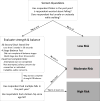Operationalisation and validation of the Stopping Elderly Accidents, Deaths, and Injuries (STEADI) fall risk algorithm in a nationally representative sample
- PMID: 28947669
- PMCID: PMC5729578
- DOI: 10.1136/jech-2017-209769
Operationalisation and validation of the Stopping Elderly Accidents, Deaths, and Injuries (STEADI) fall risk algorithm in a nationally representative sample
Abstract
Background: Preventing falls and fall-related injuries among older adults is a public health priority. The Stopping Elderly Accidents, Deaths, and Injuries (STEADI) tool was developed to promote fall risk screening and encourage coordination between clinical and community-based fall prevention resources; however, little is known about the tool's predictive validity or adaptability to survey data.
Methods: Data from five annual rounds (2011-2015) of the National Health and Aging Trends Study (NHATS), a representative cohort of adults age 65 years and older in the USA. Analytic sample respondents (n=7392) were categorised at baseline as having low, moderate or high fall risk according to the STEADI algorithm adapted for use with NHATS data. Logistic mixed-effects regression was used to estimate the association between baseline fall risk and subsequent falls and mortality. Analyses incorporated complex sampling and weighting elements to permit inferences at a national level.
Results: Participants classified as having moderate and high fall risk had 2.62 (95% CI 2.29 to 2.99) and 4.76 (95% CI 3.51 to 6.47) times greater odds of falling during follow-up compared with those with low risk, respectively, controlling for sociodemographic and health-related risk factors for falls. High fall risk was also associated with greater likelihood of falling multiple times annually but not with greater risk of mortality.
Conclusion: The adapted STEADI clinical fall risk screening tool is a valid measure for predicting future fall risk using survey cohort data. Further efforts to standardise screening for fall risk and to coordinate between clinical and community-based fall prevention initiatives are warranted.
Keywords: falls; geriatrics; injuries; measurement; screening.
© Article author(s) (or their employer(s) unless otherwise stated in the text of the article) 2017. All rights reserved. No commercial use is permitted unless otherwise expressly granted.
Conflict of interest statement
Competing interests: None declared.
Figures
References
-
- World Health Organization ALCU. WHO Global Report on Falls Prevention in Older Age. Geneva, Switzerland: 2007.
-
- Centers for Disease Control and Prevention (CDC), National Center for Injury Prevention and Control. Take a stand on falls. Atlanta: CDC; 2015.
-
- Centers for Disease Control and Prevention (CDC), National Center for Injury Prevention and Control. Web-based Injury Statistics Query and Reporting System (WISQARS) 2017
MeSH terms
Grants and funding
LinkOut - more resources
Full Text Sources
Other Literature Sources
Medical


